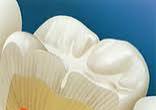Dental Sealants
The shape of many teeth make it impossible to get rid of all particles of food and sugars from within the deep grooves and pits found on the chewing surfaces, particularly in the back teeth.
These areas are sometimes the first to decay during, or maybe before, the early teenage years. Today, these decay-prone areas can be protected early on in life by the applying of a delicate layer of plastic or resin, which is bonded into the cracks and pits of the enamel of these teeth. This plastic coating is referred to as a sealant, and creates an obstruction between the tooth and the decay-causing bacteria that live in plaque which usually forms in these unmanageable areas.
What’s plaque, and why does it cause cavities?
As you or your kids eat and drink throughout the day, the food in your mouth mixes with bacteria to generate a sticky film called plaque that attaches on and in between tooth surfaces. Plaque is often found on the chewing surfaces of the back teeth, from which it is hard to remove by brushing and flossing alone. If plaque isn’t removed regularly from your teeth, it can produce acids which will attack the tooth enamel and create pits or holes ( cavities ) in the tooth. This is the first stage of tooth decay.
How can sealants help prevent cavities?
Coating the deep fissures of the teeth with a smooth plastic material makes it tougher for plaque to stick to these fine grooves on the biting surfaces of the teeth – reducing the risk of forming cavities and tooth decay.
Is it tricky to apply sealants?
No; your dentist may use a special instrument to apply the plastic sealant on your teeth, and it is an absolutely painless treatment that lasts for many years.
Who should get sealants?
Sealants are most efficient in reducing cavities in kids with newly made permanent teeth, but are also helpful in stopping the formation of decay in adult teeth. It is an effective way to reduce the requirement for fillings and more expensive treatment that might be required to repair the damage from major cavities.

